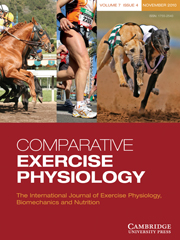Article contents
Development of a method to identify foot strike on an arena surface: application to jump landing
Published online by Cambridge University Press: 16 April 2010
Abstract
Foot strike can be difficult to determine using kinematics alone, particularly when studying equine activities on more compliant surfaces, so this study was done with the aim of developing and validating a method to determine foot strike on an arena surface that can be used in conjunction with kinematics alone, and of applying the method in the context of measuring foot strike during jump landing on an arena surface. A low-cost contact mat was developed. The timing of the contact mat switching ‘on’ was compared to the timing of a force platform onset of 20 N, load and loading rate at foot strike. Two groups of 25 participants were used in two separate studies to validate the contact mat: the first measured the difference in timing with respect to two different activities (running and stepping down from a box), and the second measured the difference in timing with respect to 1- and 2-cm depths of an arena surface during running. In a third study, the mat was used to measure leading limb foot strike of six horses during jump landing, and these data were compared to kinematics from a palmar marker on the hoof wall. All data were recorded at 500 Hz. A consistent difference in delay was found between the mat and force platform onset, and as a result, no significant differences (P>0.05) in timing delay between different loading rates or depths were found. During jump landing, foot strike (determined from the mat) occurred after the vertical velocity minima and the acceleration maxima for the hoof marker, but it occurred before the point where the rate of vertical displacement began to reduce. In conclusion, further work is needed to enhance these techniques, but these preliminary results indicate that this method may be effective in determining foot strike for field-based applications.
Information
- Type
- Research Paper
- Information
- Copyright
- Copyright © Cambridge University Press 2010
References
- 5
- Cited by

